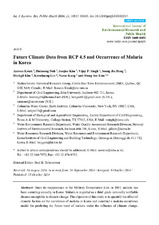| dc.description.abstract | Since its reappearance at the Military Demarcation Line in 1993, malaria has been occurring annually in Korea. Malaria is regarded as a third grade nationally notifiable disease susceptible to climate change. The objective of this study is to quantify the effect of climatic factors on the occurrence of malaria in Korea and construct a malaria occurrence model for predicting the future trend of malaria under the influence of climate change. Using data from 2001–2011, the effect of time lag between malaria occurrence and mean temperature, relative humidity and total precipitation was investigated using spectral analysis. Also, a principal component regression model was constructed, considering multicollinearity. Future climate data, generated from RCP 4.5 climate change scenario and CNCM3 climate model, was applied to the constructed regression model to simulate future malaria occurrence and analyze the trend of occurrence. Results show an increase in the occurrence of malaria and the shortening of annual time of occurrence in the future. | en |


